|

-
Pedal board for guitar FX:
-
-
- OK, we'll start of this series with an
easy one: the guitar effects pedalboard as currently used by The
Niz live onstage and in the studio.
-
- The board is actually a DIY thing made out of a cheap
briefcase that's been modified to take the top of, and fortified
with a piece of MDF that serves as the base on which the pedals
are attached to. This is done with small
pieces of velcro-tape.
- There's a second line of pedals that is
placed higher as to have easier "stomp access". It's also making
it easier to hide away the cabling of the front row pedals.
-
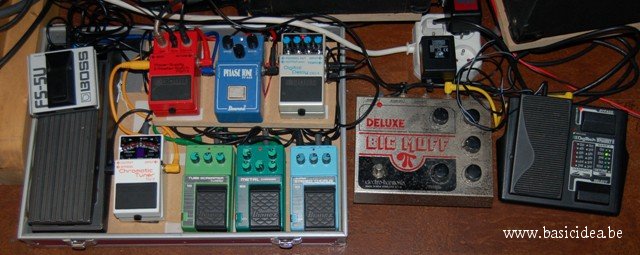
The pedals on the board are often changed
in function of the gig or studio session that is coming up. The
ones that have been on for quite some time and the "regular
guests" are the ones that are shown on the picture. The red
pedal is is the only one I don't elaborate on: it's a Boss power
supply pedal and master switch for the FX loop and I only use it
to power the other pedals, plus it provides an easy way to
connect guitar and amp quickly.
Boss volume pedal:
We'll start on the front row, from left to right:
we have the Boss volume pedal. This is for providing a volume
boost when the solo comes up. Especially when performing with
more than one guitar player in a band, this is a necessity for
live-playing. Because when playing you sometimes
need to hear yourself better and just turn your volume up a
teenie-wienee bit. And then at times you notice near the end of
the gig that the pedal is all the way up when playing rhythm...
Typically... the battle of the loudest :-)
The way I connect it: after the modulation
pedals and before the delay pedal.
Boss TU-2 Chromatic Tuner in pedal
format:
Then we have another pedal that is a "must" live
and even in the studio: a tuning device. Mine here is the Boss
TU2. I don't have it that long but it is a sturdy one. There is
a good visibility when standing straight, and you just need to
stomp on it once to activate it. At the same time it mutes the
output so the audience or studio personnel doesn't have to
listen to your tuning song.
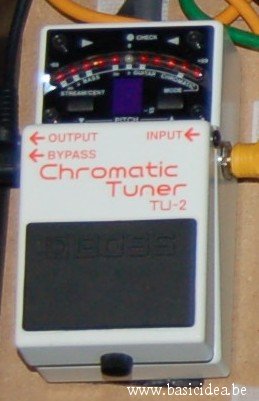
Ibanez TS10 Tube Screamer Classic:
- Description:
- This is the fourth generation of a classic overdrive
pedal and it was manufactured in the mid-eighties.
-
-
Controls: drive, tone and level pots
-
-
Inputs: mono (jack), 9V DC
-
-
Outputs: mono (jack)
-
- Sound:
-
-
My opinion:
- In a
guitar setup, I see two great ways to use this overdrive:
either as an overdrive (applying “drive” in various degrees
from clean-with-an-edge to crunch), or as a gain boost to
smoothly overdrive the input of your tube amp (playing with
the “level” control). Both work fine and provide a
nice-sounding sweet tone when used with a good guitar and
amp. Think bluesy and crunchy. It’s my main overdrive pedal
when playing live. Reacts and sounds differently when
combined with different guitars and amps and volume
settings. To my ears, the TS10 sounds better than my
(original) TS9.
-
-
Useable for: smooth overdrives, cranking up your tube
amp, level boost.
-
-
sound sample: no dedicated sample yet available, but
listen to "(Gonna) Hit The Ground" to the delayed rhythm
guitar in your right ear; you'll hear an Epiphone Casino with the TS10, SC10
and DD5, check our sounds-page.
-
- Strengths versus Weaknesses:
- Very nice tone, the 9V adaptor
input is of the same type as the Boss pedals
- Versus
- Input and output jack sockets are
mounted on PCB (goes for all the 10-series pedals, btw)
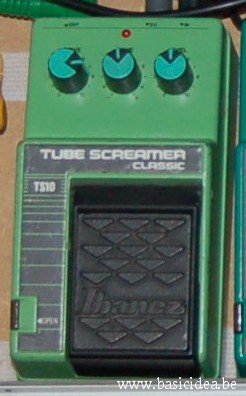
Ibanez MS10 Metal
Charger:
- Description:
- Overdrive/distortion pedal of the 10-series,
manufactured in the mid-eighties.
-
- Sound:
-
-
My opinion: Where the TS10 stops, the MS10 continues.
It provides a lot of possibilities from Tubescreamer-like
overdrive to real screaming and sustaining distortion. Also
metal sounds are possible. A back draw is the noise that
comes with the higher gain settings. This is not a problem
as long as you keep on playing, but when you stop and the
band enters a quiet passage, it’s better to switch it off,
or use a noise gate. All in all a very addictive pedal!
-
-
Useable for: screaming solos; leads or riffs that
require finger tapping, creating “walls of distortion”.
-
-
sound sample: no dedicated sample yet, but listen to
the solo guitar in "The End Of Time" and you'll hear a
stratocaster played through an MS10, check our
sounds-page.
-
- Strengths versus Weaknesses:
- Great distortion, great sustain;
the 9V adaptor input is of the same type as the Boss
pedals
- Versus
- Pedal can get noisy with higher
gain settings; input and output jack sockets are mounted
on PCB (goes for all the 10-series pedals, btw)
Note that I put the TS10 and MS10 physically close to each
other so that I can switch between them with one stomp of my
foot (eg switching between solo and rhythm).

Ibanez SC10 Super Stereo
Chorus:
- Description:
- Your basic chorus pedal with possibility to connect two
amps and thus create a wide-sounding stereo; it was made in the mid-eighties.
-
- Sound:
-
-
My opinion: it provides a nice chorus ranging from
subtle to "thick", it always gives a slight volume boost. I
personally like it when a modulation pedal does this,
because often this effect is used playing clean or "cleanish",
so I always welcome the small increase in volume when I
activate it in a live situation. Adds an eighties feel to
your sound. I didn't try connecting two amps to it, so I
can't tell whether the stereo is really that "super". Mono
it is OK.
-
-
Useable for: rhythm guitar, "Andy Summers-like
stuff" and "We're sooo in love"-songs.
-
-
sound sample: no dedicated
sample yet available, but listen to "(Gonna) Hit The Ground"
to the delayed rhythm guitar in your right ear; you'll hear an Epiphone Casino
with the TS10, SC10 and DD5. You can also hear it in "The
End Of Time": the rhythm guitar panned to the right is a
strat combining the SC10 and the PT909 (see below), check
our sounds-page.
-
- Strengths versus Weaknesses:
- Slight volume boost and nice
sound, the 9V adaptor input is of the same type as the
Boss pedals
- Versus
- input and output jack sockets are
mounted on PCB (goes for all the 10-series pedals, btw)
-
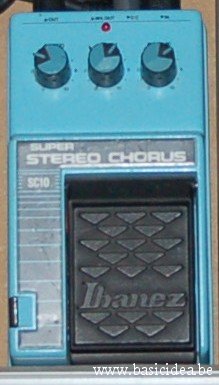
Ibanez PT-909 Phase
Tone:
- Description:
- Interesting phaser from the late 70's/early 80's and
from the same range as the famous first-generation "TS-808
Tube Screamer".
-
- Sound:
-
-
My opinion: this is a very good sounding phaser. It's
not noisy, the switch is impeccable, and most importantly:
the sound is super! Very usable on reggae-like rhythms and
just as a lush phaser in rock songs. You can also dial in a
fast speed setting making it sound like a sort of fast
leslie simulation, but with a sound that reminds me of the
late 60's Beatles and Hendrix. The pedal doesn't give a
boost in volume when activated. Be careful with the feedback
knob, it can be quite edgy on its sweep in combination with
eg a telecaster.
-
-
Useable for: rhythm guitar, reggae-stuff (with slow
speed setting), "Andy Summers and Edward Van Halen-like
stuff", leslie simulation (with fast speed setting)
-
-
sound sample: no dedicated
sample yet available, but you can hear it in "The End Of
Time": the rhythm guitar panned to the right is a strat
combining the SC10 and the PT909 (see below), check our
sounds-page.
-
- Strengths versus Weaknesses:
- Very nice and lush sound, great
switch
- Versus
- 9V input is rather non-standard
(different as the current Boss connectors)
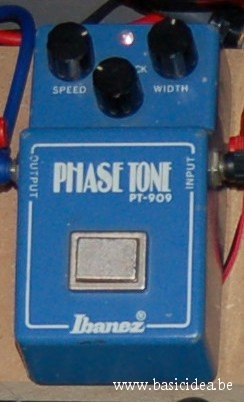
Boss DD5 Digital Delay:
- Description:
- Delay pedal with stereo (panning) output and tempo input
and a lot of musical possibilities; made in the 90's.
-
- Sound:
-
-
My opinion: one great pedal! In the mid-nineties this
was the only delay pedal I could find that had the tap-tempo
option (you need a seperate pedal for that; I use the Boss
FS-5U for this - visible in the overview picture on top of
this page). Whenever you need a delay that has to be synced
to the rest of the band, this is a very easy way to do it.
Just tap two times during the count-in and off you go! Small
delay settings are also interesting. There is also a sort of
loop-function in which the DD5 records and replays a couple
of seconds, making it possible to layer your input over and
over, and thus making very weird loops. Even the panning out
can be useful: when connecting two amps it will hard-pan
your delays left and right. Try it, it is a nice experience
standing in the middle of two amps panning the night away
;-) Or, in case you need to have your guitar signal split to
stereo for the studio, this is one way to do it.
-
-
Useable for: solos and fills mainly. Also special fx,
eg you can let it oscillate.
-
-
sound sample: no dedicated
sample yet available, but listen to "(Gonna) Hit The Ground"
to the delayed rhythm guitar panned to the right; you'll hear an Epiphone Casino
with the TS10, SC10 and DD5. Check our
sounds-page.
-
- Strengths versus Weaknesses:
- Great sound, possibility to set
tempo with your foot (hard to work without this feature
live), great when using two amps in stereo
- Versus
- hard to find weaknesses here,
perhaps one super small one: it stays activated after
powering it up - you need to keep this in mind when
playing live and setting up quickly
-

Digitech Whammy II:
- Description:
- Second generation of the world famous whammy pedal from
Digitech, made in the nineties and brought to my attention
by Tom Morello and Dweezil Zappa.
-
- Sound:
-
-
My opinion: seemless pitch variation with workable
ranges (up and down, two octaves up and down, and a lot
more). These up and down presets are, like most pitch
shifting devices of that era, only workable when playing ONE
note. You can play more notes, but then the whammy will not
know which one to process and the result is a "flickering"
sound (this is an effect in itself, check out Tom Morello on
RATM). I also like the third "shift" setting called "2ND
down". Here I have the impression that it is possible
to play multiple notes and the shifter shifts them all.
Backdraws: I find it a bit noisy, and I have the feeling
that it is sucking tone when residing in my effects chain.
That's why I don't put it in my FX-case permanently, only
when it is required for a certain song. I'd like to get some
sort of true bypass switching system for it one day. Always
put it in front of your other guitar FX (first pedal after your guitar, or it might
have trouble recognizing the pitch of the notes that you
play).
-
-
Useable for: crazy pitch dives and jumps..., special
FX,...
-
-
sound sample: no dedicated
sample yet available.
-
- Strengths versus Weaknesses:
- Great effect, a lot of
possibilities
- Versus
- a bit noisy, and I have the
impression that it sucks tone
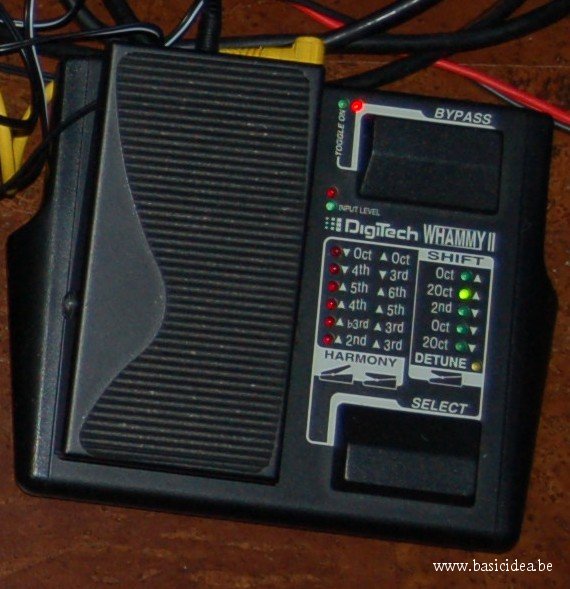
Electro Harmonix Deluxe
Big Muff Pi ("distorter-compressor"):
- Description:
- Fuzz effect with compression.
-
- Sound:
-
-
My opinion: The Deluxe Big Muff is not a regular
visitor in my pedal board, but just happened to be on the
picture as I was fooling around with it at the time. So I
might as well elaborate a bit. It is a fuzz and can make
your guitar roar or sound really dirty. Think "The White
Stripes" or sixties garage rock. The unit I have is an
original one from (I think) the seventies and is in a rather
poor cosmetic condition with small dots of rust on the
frontplate. Technically it works fine. The compression is OK,
but I don't use it a lot.
-
-
Useable for: rhythm, solos and fills, Jack White-like
fuzz (great in combination with the Whammy)
-
-
sound sample: no dedicated
sample yet available.
-
- Strengths versus Weaknesses:
- It's able to make your guitar sound dirty, and it has
it's own 240V AC-plug
- Versus
- Rather big size - takes up a lot of pedal board real
estate
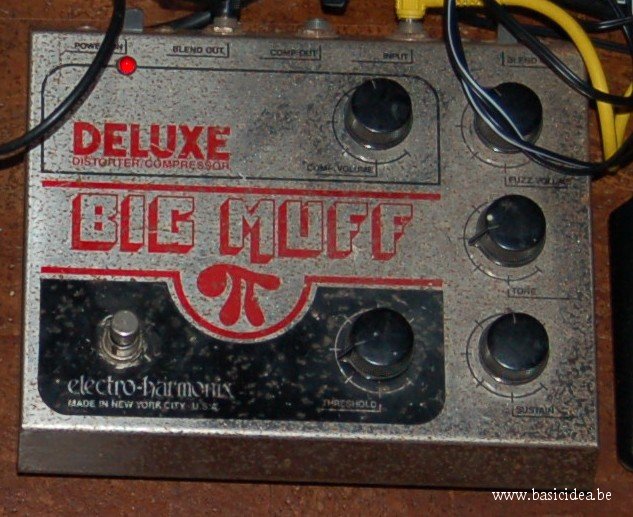
That's it for now, more to come later!
|
|

 Music, lyrics and photographs on this
website are licensed under a
Creative Commons Attribution-Noncommercial-No Derivative Works 2.0 Belgium License.
Music, lyrics and photographs on this
website are licensed under a
Creative Commons Attribution-Noncommercial-No Derivative Works 2.0 Belgium License.
